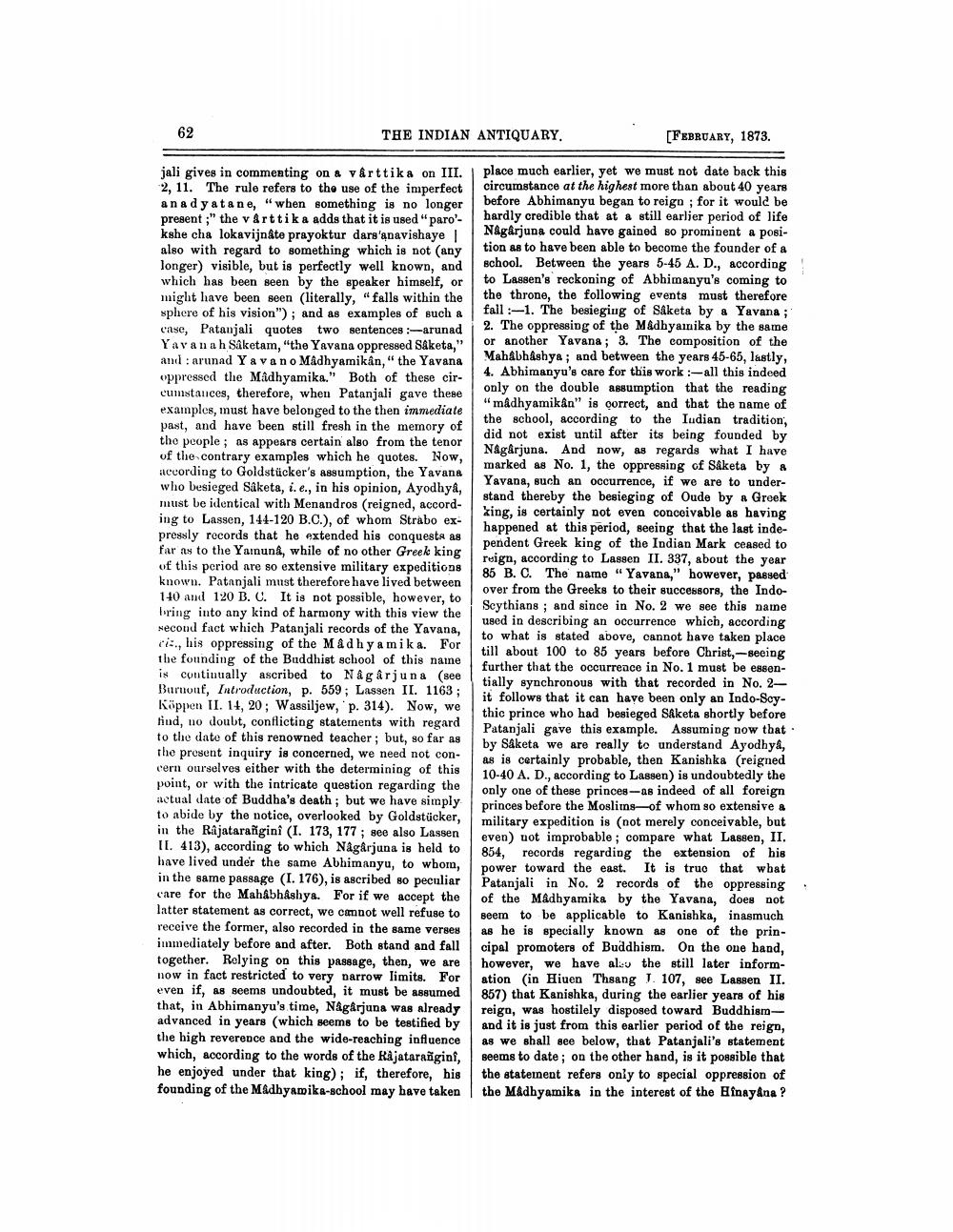________________
62
THE INDIAN ANTIQUARY.
jali gives in commenting on a vârttika on III. | 2, 11. The rule refers to the use of the imperfect anadyatane, "when something is no longer present;" the vårt tika adds that it is used "paro'kshe cha lokavijnâte prayoktur dars'anavishaye | also with regard to something which is not (any longer) visible, but is perfectly well known, and which has been seen by the speaker himself, or might have been seen (literally, "falls within the sphere of his vision"); and as examples of such a case, Patanjali quotes two sentences :-arunad Yavanah Sâketam, "the Yavana oppressed Sâketa," and: arunad Y a va no Madhyamikân," the Yavana oppressed the Mâdhyamika." Both of these circumstances, therefore, when Patanjali gave these examples, must have belonged to the then immediate past, and have been still fresh in the memory of the people; as appears certain also from the tenor of the contrary examples which he quotes. Now, according to Goldstücker's assumption, the Yavana who besieged Saketa, i. e., in his opinion, Ayodhya, must be identical with Menandros (reigned, according to Lassen, 144-120 B.C.), of whom Strabo expressly records that he extended his conquests as far as to the Yamuna, while of no other Greek king of this period are so extensive military expeditions known. Patanjali must therefore have lived between 140 and 120 B. C. It is not possible, however, to bring into any kind of harmony with this view the second fact which Patanjali records of the Yavana, ciz, his oppressing of the Madhyamika. For the founding of the Buddhist school of this name is continually ascribed to Nagarjuna (see Buruouf, Introduction, p. 559; Lassen II. 1163; Köppen II. 14, 20; Wassiljew, p. 314). Now, we find, no doubt, conflicting statements with regard to the date of this renowned teacher; but, so far as the present inquiry is concerned, we need not concern ourselves either with the determining of this point, or with the intricate question regarding the actual date of Buddha's death; but we have simply to abide by the notice, overlooked by Goldstücker, in the Rajatarañginî (I. 173, 177; see also Lassen II. 413), according to which Nagarjuna is held to have lived under the same Abhimanyu, to whom, in the same passage (I. 176), is ascribed so peculiar care for the Mahabhâshya. For if we accept the latter statement as correct, we cannot well refuse to receive the former, also recorded in the same verses immediately before and after. Both stand and fall together. Relying on this passage, then, we are now in fact restricted to very narrow limits. For even if, as seems undoubted, it must be assumed that, in Abhimanyu's time, Nagarjuna was already advanced in years (which seems to be testified by the high reverence and the wide-reaching influence which, according to the words of the Rajataranginî, he enjoyed under that king); if, therefore, his founding of the Madhyamika-school may have taken
[FEBRUARY, 1873.
place much earlier, yet we must not date back this circumstance at the highest more than about 40 years before Abhimanyu began to reign; for it would be hardly credible that at a still earlier period of life Nagarjuna could have gained so prominent a position as to have been able to become the founder of a school. Between the years 5-45 A. D., according to Lassen's reckoning of Abhimanyu's coming to the throne, the following events must therefore fall-1. The besieging of Såketa by a Yavana; 2. The oppressing of the Madhyamika by the same or another Yavana; 3. The composition of the Mahabhashya; and between the years 45-65, lastly, 4. Abhimanyu's care for this work :-all this indeed only on the double assumption that the reading "mâdhyamikân" is correct, and that the name of the school, according to the Iudian tradition, did not exist until after its being founded by Nagarjuna. And now, as regards what I have marked as No. 1, the oppressing of Saketa by a Yavana, such an occurrence, if we are to understand thereby the besieging of Oude by a Greek king, is certainly not even conceivable as having happened at this period, seeing that the last independent Greek king of the Indian Mark ceased to reign, according to Lassen II. 337, about the year 85 B. C. The name "Yavana," however, passed over from the Greeks to their successors, the IndoScythians; and since in No. 2 we see this name used in describing an occurrence which, according to what is stated above, cannot have taken place till about 100 to 85 years before Christ,-seeing further that the occurrence in No. 1 must be essentially synchronous with that recorded in No. 2it follows that it can have been only an Indo-Scythic prince who had besieged Saketa shortly before Patanjali gave this example. Assuming now that by Saketa we are really to understand Ayodhya, as is certainly probable, then Kanishka (reigned 10-40 A. D., according to Lassen) is undoubtedly the only one of these princes-as indeed of all foreign princes before the Moslims-of whom so extensive a military expedition is (not merely conceivable, but even) not improbable; compare what Lassen, II. 854, records regarding the extension of his power toward the east. It is true that what Patanjali in No. 2 records of the oppressing of the Madhyamika by the Yavana, does not seem to be applicable to Kanishka, inasmuch as he is specially known as one of the principal promoters of Buddhism. On the one hand, however, we have also the still later information (in Hiuen Thsang J. 107, see Lassen II. 857) that Kanishka, during the earlier years of his reign, was hostilely disposed toward Buddhismand it is just from this earlier period of the reign, as we shall see below, that Patanjali's statement seems to date; on the other hand, is it possible that the statement refers only to special oppression of the Madhyamika in the interest of the Hinayana ?




